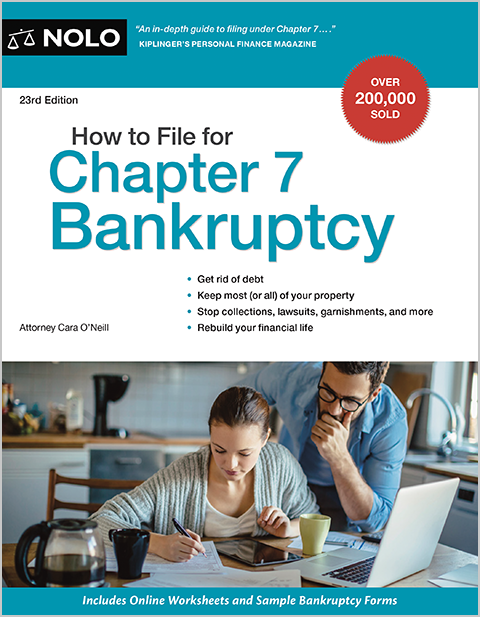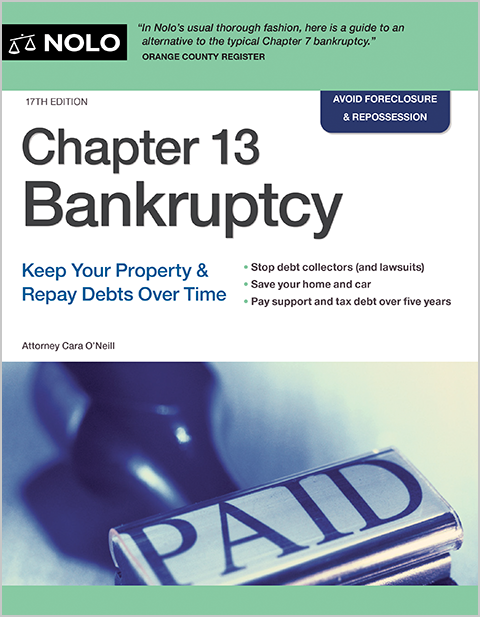Learn how often you can erase qualifying debts in bankruptcy.
If you've filed for bankruptcy in the past, you might be wondering how often you can file for bankruptcy. The simple answer? You can receive a Chapter 7 bankruptcy discharge every eight years. But you won't need to wait that long if you filed a different chapter before, such as Chapter 13, or if you plan to file another chapter. Your waiting period depends on the chapter you filed previously and the chapter you'll file next (the waiting period is calculated from filing date to filing date, not from the previous bankruptcy discharge date).
If you want to find out the waiting period fast, skip to the "How Often You Can File for Bankruptcy" chart below. Keep reading to learn why you must wait before wiping out debts in another Chapter 7 or Chapter 13, and about problems you could face when filing for bankruptcy too often.
- How Many Times Can You File for Bankruptcy?
- "How Often You Can File for Bankruptcy" Chart
- How Often You Can File Under the Same Bankruptcy Chapter: Chapter 7 and Chapter 13
- How Long You Wait to File a Different Bankruptcy Chapter: The Order Matters
- When Filing for Bankruptcy Without a Discharge Might Be Beneficial
- What If You Didn't Receive a Discharge in the First Bankruptcy Case?
- When Are Multiple Bankruptcy Filings Abusive?
- Need More Bankruptcy Help?
How Many Times Can You File for Bankruptcy?
You can file for bankruptcy as many times as you like. Bankruptcy laws don't limit people to a particular number of bankruptcies and don't set a minimum period you must wait before filing again. However, there's a catch. If you file too soon after wiping out debt in your old case, you won't be eligible for another "debt discharge" in your new case. The waiting period must expire before you qualify for more debt forgiveness.
Although it can make sense to file for bankruptcy without receiving a discharge, such situations are rare. Learn about timing your bankruptcy filing to avoid wasting time and money.
"How Often You Can File for Bankruptcy" Chart
Here's how long you'll wait before qualifying for another bankruptcy discharge. Use your previous bankruptcy filing date as the starting point, not the discharge date.
|
Plan to File for Chapter 7 |
Plan to File for Chapter 13 |
|
|
Previously Filed for Chapter 7 |
Eight years |
Four years |
|
Previously Filed for Chapter 13 |
Six years or less |
Two years |
How Often You Can File Under the Same Bankruptcy Chapter: Chapter 7 and Chapter 13
These are the same timeframes in the chart above, but here, you'll find examples to help you calculate when you'll qualify for another discharge.
- You can file a second Chapter 7 in eight years. Begin counting from the filing date of your previous Chapter 7. For example, Bella filed for Chapter 7 bankruptcy on August 1, 2017. She'll qualify for another Chapter 7 discharge if she files on or after August 1, 2025.
- You can file a second Chapter 13 in two years. Begin counting from the filing date of your previous Chapter 13. Les filed for Chapter 13 on November 1, 2022. He'll be eligible for another Chapter 13 discharge on or after November 1, 2024.
How Long You Wait to File a Different Bankruptcy Chapter: The Order Matters
You'll use these if the bankruptcy chapter you intend to file differs from the previous one. Again, the waiting periods mirror those in the chart, but we explain an exception that applies if you initially filed for Chapter 13.
- If you filed under Chapter 7, the waiting period for a Chapter 13 case is four years.
- If you filed under Chapter 13, the waiting period for a Chapter 7 case is six years.
Chapter 13 exception. People who previously filed a Chapter 13 case and fully paid "unsecured creditors" or, in other words, paid everything other than what was owed on houses, cars, and other collateralized property won't wait as long before filing for Chapter 7. The same is true for Chapter 13 filers who paid at least 70% of unsecured claims, proposed a plan in good faith, and made their best effort to pay creditors. Talk with a local bankruptcy attorney for more information.
Learn who can't file bankruptcy Chapter 7 and how to file bankruptcy Chapter 13 instead.
When Filing for Bankruptcy Without a Discharge Might Be Beneficial
Sometimes, you don't need a discharge because filing for bankruptcy solves another problem. For instance, businesses (except sole proprietors) are never entitled to a Chapter 7 discharge, yet closing companies sometimes file for Chapter 7. Here's why.
It's tempting for a company's interest holders to hide assets instead of using them to pay creditors as they should when winding down a business. Because liquidating assets transparently can help minimize accusations of wrongdoing from creditors, having a court-appointed trustee sell business assets and distribute funds to creditors can be helpful.
Although it isn't used much, the same approach is available to individual filers, and it's one way to benefit from bankruptcy without receiving a discharge.
More often, individuals not entitled to a discharge turn to Chapter 13 to force a creditor into a repayment plan. For instance, suppose you have a creditor threatening to take your home or file a wage garnishment. If you didn't have the cash to pay the entire debt but could make smaller payments, you'd need time, not a discharge. Filing for Chapter 13 would be a viable solution.
A "Chapter 20" bankruptcy is similar and starts when a filer discharges all qualifying debts in Chapter 7. Immediately afterward, the debtor uses a Chapter 13 bankruptcy payment plan to pay nondischargeable debts not erased in Chapter 7.
Keep in mind that some courts don't allow Chapter 20 filings. Also, they can be tricky because your income would need to be low enough to qualify for Chapter 7 yet high enough to afford a Chapter 13 plan. Talk with a local bankruptcy lawyer before attempting to use Chapter 20 as a debt relief strategy.
What If You Didn't Receive a Discharge in the First Bankruptcy Case?
In most situations, if you didn't receive a bankruptcy discharge the first time, you can file again and receive a discharge. But not always.
- Suppose the court dismissed the first case. Unless the court orders otherwise, you can file again. A 180-day waiting period might apply if you failed to obey a court order or voluntarily dismissed the case after a creditor filed a motion to lift the bankruptcy stay.
- Suppose the court denied your discharge. You might be able to file again, but you probably won't be entitled to discharge the debts listed in your first case. Because of the unusual circumstances, consider seeking the advice of an experienced bankruptcy lawyer.
Also, you should know that you lose the full benefits of the automatic stay order that stops creditors from collecting when you file multiple bankruptcies quickly. The stay would last 30 days if you filed one previous time during the past year. The court wouldn't issue the stay if you had already filed twice in the past year.
Learn more about repeat filings and the automatic stay.
When Are Multiple Bankruptcy Filings Abusive?
The term "abusive bankruptcy filing" can refer to a Chapter 7 filing that doesn't meet the means test, the qualification standard determining a filer's right to a debt discharge. But it can also describe a case filed by someone inappropriately using the bankruptcy process, for instance, to evade a creditor or buy time in a foreclosure or lawsuit.
Simply put, the court frowns on debtors who file with no intention of following through with the case. Repeat filers face consequences for these tactics, such as losing the automatic stay discussed or a discharge.
Learn why the court might dismiss your bankruptcy case.
Need More Bankruptcy Help?
Did you know Nolo has made the law accessible for over fifty years? It's true, and we wholeheartedly encourage research and learning. You can find many more helpful bankruptcy articles on Nolo's bankruptcy homepage. For instance, Nolo articles will explain what bankruptcy can do, what you'll want to avoid before filing for bankruptcy, and more. Information needed to complete the official downloadable bankruptcy forms is on the Department of Justice U.S. Trustee Program website.
However, online articles and resources can't address all bankruptcy issues and aren't written with the facts of your particular case in mind. The best way to protect your assets in bankruptcy is by hiring a local bankruptcy lawyer.
|
|
- How Many Times Can You File for Bankruptcy?
- "How Often You Can File for Bankruptcy" Chart
- How Often You Can File Under the Same Bankruptcy Chapter: Chapter 7 and Chapter 13
- How Long You Wait to File a Different Bankruptcy Chapter: The Order Matters
- When Filing for Bankruptcy Without a Discharge Might Be Beneficial
- What If You Didn't Receive a Discharge in the First Bankruptcy Case?
- When Are Multiple Bankruptcy Filings Abusive?
- Need More Bankruptcy Help?

